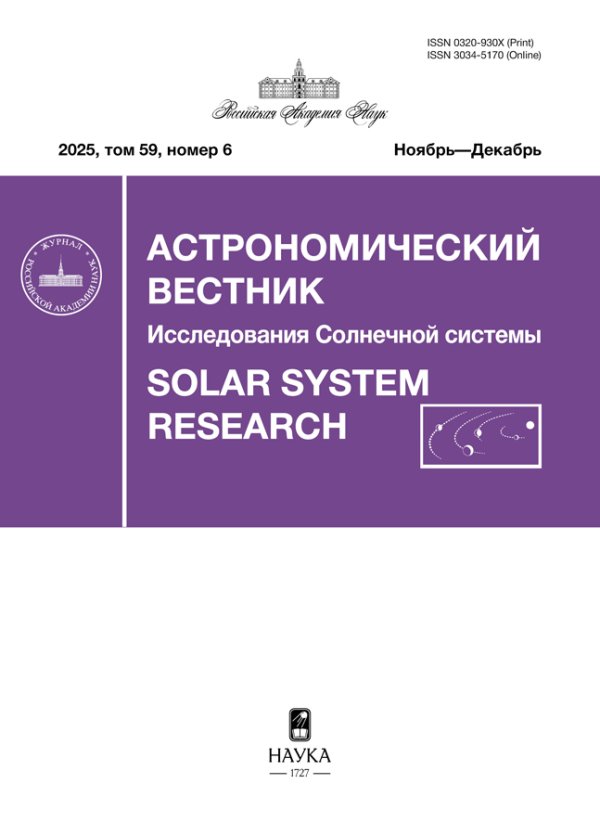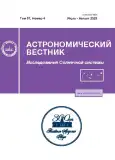Том 57, № 4 (2023)
Статьи
Самородные металлы ряда никель–железо из импактитов кратера Лонар (Индия) и реголита Луны
Аннотация
Кратер Лонар (Индия) является наиболее сохранившимся и наиболее изученным на Земле, образованным в базальтах, что позволяет проводить сравнительное изучение с импактными преобразованиями минерального вещества на Луне и других планетах Солнечной системы. Как показали сравнительные исследования, материал ударника, как на Земле, так и на Луне, присутствует в импактитах не только в геохимически рассеянном виде, как считалось ранее, но и в форме отдельных субмикронных частиц, распределенных в расплавленном материале мишени. В расплавных импактитах кратера Лонар обнаружены частицы самородного никеля, тэнита и высоконикелевого камасита, которые, видимо, являются преобразованным материалом ударника. Высоконикелевые субмикронные металлические включения широко распространены в импактитах кратера Лонар, поскольку они были обнаружены во всех изученных препаратах, изготовленных из материалов, собранных из разных точек по краю кратера. Обнаруженные в настоящем исследовании высоконикелевые частицы являются дополнительным аргументом в пользу ранее высказанного предположения о хондритовом типе ударника.
 295-306
295-306


Прибор ODS миссии ЭкзоМарс-2022: моделирование и наземные полевые измерения
Аннотация
В работе представлены результаты моделирования и наземных полевых измерений прибора ODS (ODS – Optical Depth Sensor), предназначенного для исследования аэрозоля в марсианской атмосфере посредством ежедневных измерений освещенности на поверхности планеты. Прибор являлся частью метеокомплекса, размещенного на посадочной платформе миссии ЭкзоМарс-2022. В статье приведены устройство прибора, его оптическая схема и спектральные характеристики двух каналов. Описаны основные элементы модели для расчета потока излучения, измеряемого прибором, в зависимости от структуры атмосферы, взвешенного в ней аэрозоля и суточного движения Солнца. Расчеты проводились в приближении псевдосферической атмосферы с учетом многократного рассеяния излучения. С использованием созданной модели, адаптированной для земной атмосферы, проведено моделирование сигнала прибора ODS для двух серий наземных полевых измерений на разных широтах. Измеренные суточные зависимости в сравнении с результатами моделирования позволяют определить оптическую толщину с точностью 0.1.
 307-318
307-318


Датчики температуры и давления метеокомплекса для иследования атмосферы Марса
Аннотация
Датчики температуры и давления, входящие в состав метеорологического комплекса посадочного платформы (ПП) ЭкзоМарс-2022, предназначены для измерения основных параметров атмосферы Марса: температуры, давления, вертикальной компоненты скорости ветра. Измерения температуры и давления начинаются во время спуска, после отделения нижней полусферы, когда высота над поверхностью будет составлять от 2.1 до 8.5 км в зависимости от траектории спуска. Выше, до раскрытия парашюта, вертикальный профиль атмосферы может быть получен с помощью блока акселерометров, также входящего в метеорологический комплекс. После посадки проводится длительный мониторинг приповерхностного слоя атмосферы. Измерения проводятся на различной высоте от поверхности. С учетом измерения вертикальной компоненты ветра после посадки рассчитывается локальный тепловой поток поверхность–атмосфера. Полученные измерения позволяют получить динамику взаимодействия атмосферы и поверхности. В статье рассмотрены научные задачи, решаемые датчиками, кратко описана программа измерений и детально описаны датчики и их характеристики.
 319-332
319-332


Акселерометры метеокомплекса для иследования верхней атмосферы Марса
Аннотация
Акселерометры и датчик угловых скоростей, входящие в состав метеорологического комплекса посадочной платформы (ПП) ЭкзоМарс-2022, предназначены для измерения ускорения во время торможения посадочного аппарата в атмосфере Марса. На основе полученных данных рассчитываются основные параметры атмосферы Марса: плотность, давление и температура. После посадки датчики используются для определения ускорения на поверхности и вибрационных воздействий на посадочный аппарат различной природы. Датчики активизируются до входа в атмосферу и работают во время всего спуска до посадки. После посадки проводится длительный мониторинг на выявление вибрационных воздействий со стороны атмосферы и поверхности. В статье рассмотрены научные задачи, решаемые датчиками, описана программа измерений и детально рассмотрены конструкция датчиков и их характеристики.
 333-341
333-341


Лидар для исследования атмосферы Марса с поверхности
Аннотация
Прибор Лидар в составе метеорологического комплекса Посадочной платформы ЭкзоМарс-2022 предназначен для исследования марсианского аэрозоля, пограничного слоя, и мелкомасштабной атмосферной турбулентности. Миниатюрный лидар на основе импульсного полупроводникового лазера и лавинного фотодиода в режиме счета фотонов позволит получать профили обратного рассеяния аэрозоля на вертикальной трассе от 10 до 1500 м днем и от 15 до 10 000 м ночью. В пассивном режиме яркость неба измеряется в узком спектральном диапазоне и в узком телесном угле с частотой до сотен герц. Измеряемые флуктуации могут дать информацию о турбулентности дневной атмосферы и ее связи с пылевой активностью. В статье рассмотрены научные задачи эксперимента, программа измерений на поверхности Марса и подробно описаны составные части аппаратуры и особенности их работы.
 342-356
342-356


Определение параметров движения околоземных объектов по позиционным измерениям, выполненным на Терскольской обсерватории
Аннотация
В работе представлена методика обработки позиционных наблюдений околоземных объектов с помощью численной модели движения ИСЗ, разработанной в Научно-исследовательском институте прикладной математики и механики Томского государственного университета (НИИ ПММ ТГУ). Среднеквадратическая ошибка улучшения орбиты без отбраковки наблюдений для таких объектов не превышает 0.3″ на семисуточном интервале времени. Получены результаты представления наблюдений на следующее появление объекта, что позволяет находить объект на интервале времени 5 мес. Уточнена орбита при совместной обработке измерений по нескольким появлениям объекта на полугодовом интервале времени. Все результаты получены по наблюдениям, выполненным на оборудовании центра коллективного пользования “Терскольская обсерватория”.
 357-364
357-364


Вековая орбитальная динамика кандидатов в спутники экзопланет
Аннотация
Проведен анализ устойчивости вековой орбитальной динамики ряда потенциально существующих спутников экзопланет. Установлен устойчивый характер вековой динамики возможных спутников (“экзолун”) у планет KOI-268.01, Kepler-1000b и Kepler-1442b. Для указанных систем получены оценки возможных значений орбитальных параметров экзолун. Рассмотрена динамика обнаруженных из анализа наблюдений спутников у планет Kepler-1625b и Kepler-1708b. Установлено, что большая полуось орбиты спутника планеты Kepler-1625b может иметь величину от 5 до 25 радиусов планеты. Показано, что имеющееся для спутника планеты Kepler-1708b решение (Kipping и др., 2022) соответствует устойчивой орбите спутника.
 365-372
365-372


Оценивание вероятности столкновения астероидов с Землей при заметной нелинейности в задаче улучшения орбиты
Аннотация
Разработан метод оценивания вероятности столкновения астероидов с Землей, основанный на выявлении трубок столкновительных орбит в начальной доверительной области с учетом нелинейности в задаче улучшения орбиты. Метод заключается в последовательной переборке уровенных поверхностей минимизируемой функции и условной минимизации на них расстояния от астероида до Земли в каком-либо его рассматриваемом сближении. Разработан приближенный способ вычисления доверительной вероятности в любой точке начальной области при заметной нелинейности в задаче улучшения орбиты. Оценивание вероятности столкновения выполняется путем применения этого способа для выявленной трубки столкновительных орбит. Метод апробирован для ряда потенциально опасных астероидов в их ожидаемых сближениях с Землей.
 373-384
373-384


Ультранизкочастотные резонаторы: к 80-летию открытия волн Альвена
Аннотация
Представление о волнах Альвена, введенное в науку 80 лет тому назад, сыграло большую роль в становлении и развитии космической электродинамики. Волны Альвена отличаются тем, что в каждой точке пространства вектор групповой скорости и вектор внешнего магнитного поля коллинеарны друг другу, благодаря чему волны могут переносить импульс, энергию и информацию на большие расстояния. В память о выдающемся событии мы кратко описываем два резонатора Альвена, один из которых располагается высоко над Землей, в радиационном поясе, а второй – в ионосферных слоях. Оба резонатора имеют дискретный спектр в верхней части диапазона ультранизкочастотных колебаний естественного происхождения (ориентировочно от 0.2 до 7 Гц). Особо подчеркивается теснейшая связь представления о волнах Альвена с сегодняшними проблемами электродинамики геофизических сред.
 385-388
385-388












